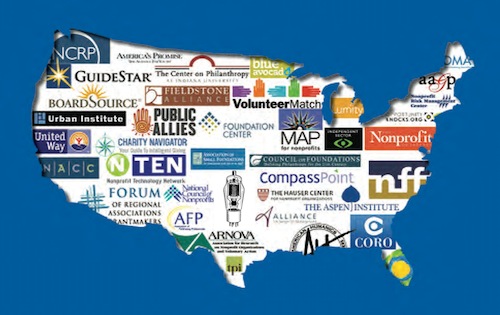Nonprofit infrastructure and the organizations that build it

There is a lot of meat to the Nonprofit Quarterly’s “Study on Nonprofit and Philanthropic Infrastructure” (hat-tip Rosetta Thurman). The introduction from Elizabeth Boren, research director at the Urban Institute puts the infrastructure in perspective:
If I were to describe the network of organizations that supports the nonprofit sector, I would not use the word infrastructure, which connotes a fixed and unchanging support system. These organizations are hardly the static bones of the sector; rather, they are the interactive forces that transmit information and propel change. This network connects civil-society organizations through its hubs, which create opportunities for peer-to-peer learning and shared experiences as well as for improving practices, conducting and using research, and developing ethical standards. At their best, support organizations are propellants that drive organizations to excel. They promote an overarching view of the nonprofit sector’s role in society by articulating the collective challenges of organizations and their constituents and by developing alternatives to address these challenges.
What are the implications of this dynamic perspective? It puts the focus on how the support network connects a diversity of organizations and facilitates their interaction with the wider environment. The recent presidential campaign, whose Web revolution so engaged the young, illustrates these dynamics. Networks embody speed, flexibility, interactivity, and a high tolerance for volatility, negative feedback, and redundancy. Successful network hubs provide quality content and a variety of communication and engagement options.
Building on this idea of dynamism, both across the nonprofit sector as well as within our own public media infrastructure, is identifying the specific actions this network should enable:
To respond to this challenging environment in a rapid and well informed way, nonprofits of all sizes and shapes, but especially, the majority which are small or mid-sized, need the connective tissue of infrastructure to, among other things:
- restructure their practices, services, and organizations to fit a resource-scarce environment;
- identify and pursue available resources;
- track important trends in government and communities;
- identify potentially useful innovations in practice, financing, and organizational structure occurring elsewhere;
- engage in collective policy development and advocacy.
Sound a little familiar?
Digging deeper, the study clearly articulates one of the greatest challenges: “the nonprofit infrastructure lacks the reach to serve the vast majority of the sector which is made up of small to mid-size nonprofits, most of which are very local and very deeply woven into the fabric of their own communities.”
Fortunately, the Transmission Project is an outlier there, as well as here:
Most infrastructure organizations are not digital natives and need help in rethinking their design to include the most optimal use of new technological tools.
And here on Human Resources:
Many described the area of force concerns as behind the curve, with people and groups “playing around the edges” or addressing discrete issues such as executive transitions and recruitment. One interviewee suggests that the conversation has been too narrowly cast, and that discussions of the sector’s use of “human capital” should include ideas on how to effectively engage and retain unpaid as well as paid talent. This discussion is, no doubt, going to be played out loudly in the next few years as national initiatives based on service gain traction and steam.
Reinforcing our views that organizations are capable but under-resourced—locally designed solutions succeed if provided broadly based support—the study identifies an undermining perspective shift from asset to deficit orientations:
Over the past twenty years or so there has been an increasingly strident narrative that promotes the view that many or most nonprofits are dysfunctional and need to be fixed. A deeper look reveals that the financial and political markets which nonprofits must regularly negotiate are complex and difficult, requiring a variety of what Jim Collins calls high legislative leadership skills.
But unfortunately there is a counter-trend in the wider philanthropic community: ‘the increasing penchant among some foundations “to bypass nonprofits altogether in trying to achieve their goals.” ’
Lastly, what makes for a good infrastructure support organization:
Some respondents pointed out that among MSOs [Management Support Organizations], there are pockets of excellence, where the practice and thought leadership are exemplary. These organizations, they added, also tend to combine capacity building with research and publishing.



Comments
Post new comment